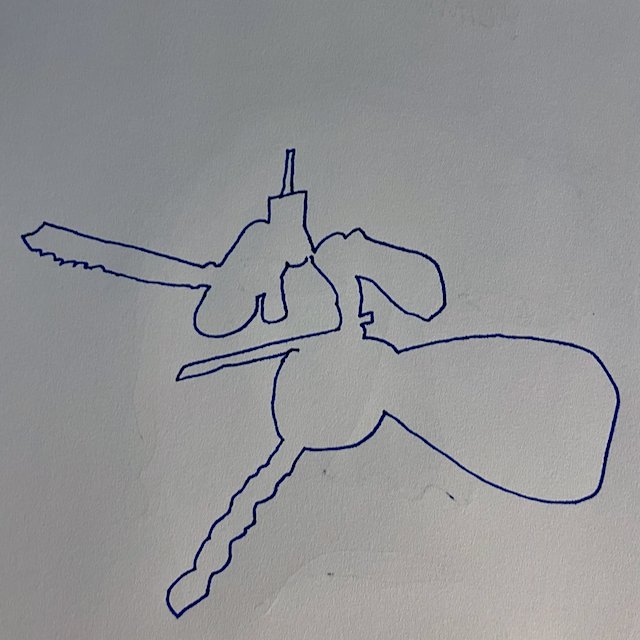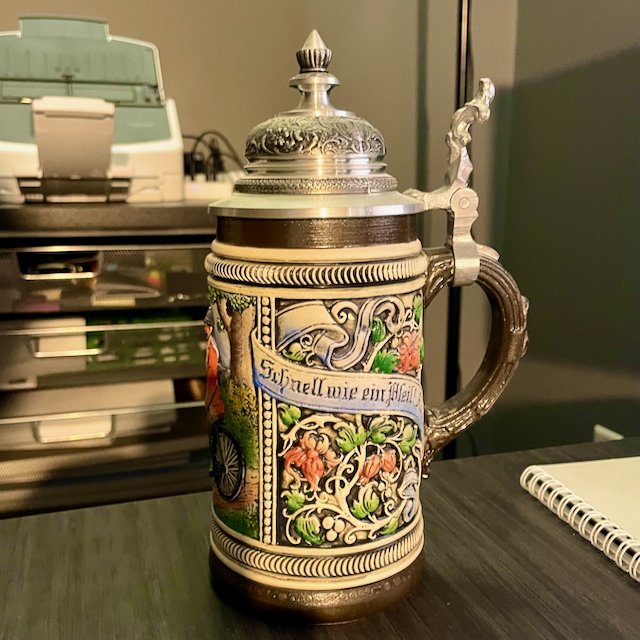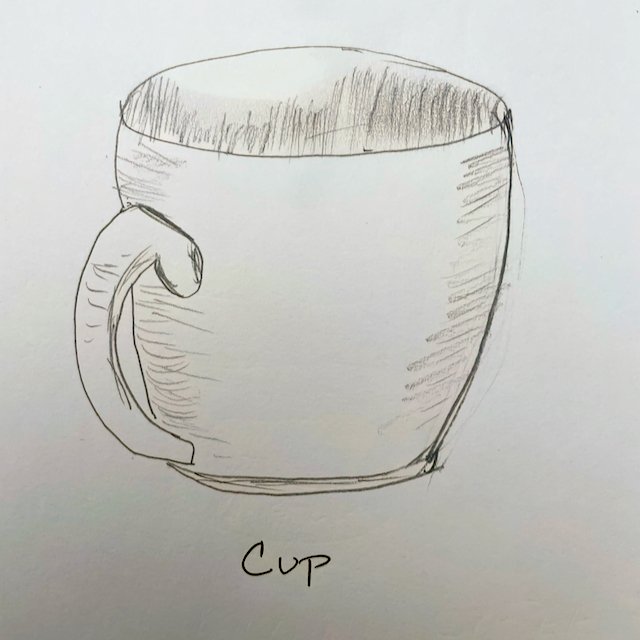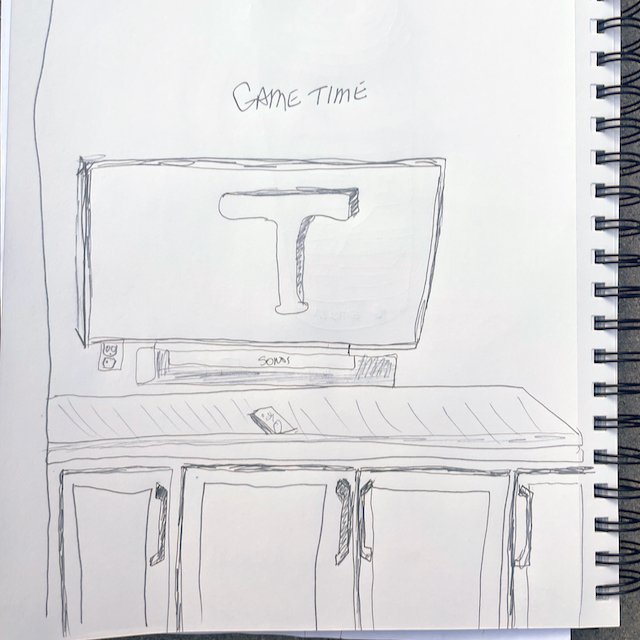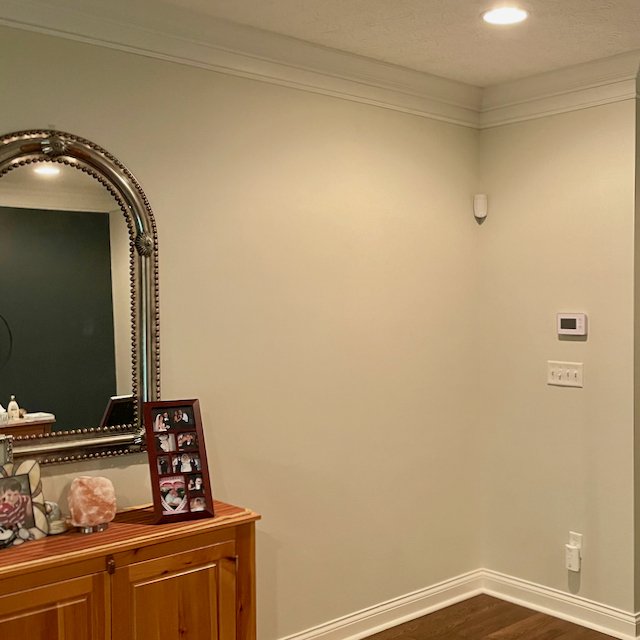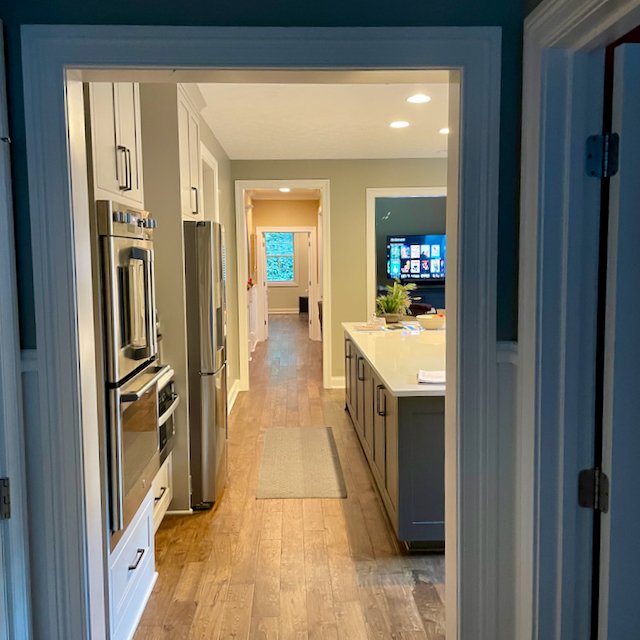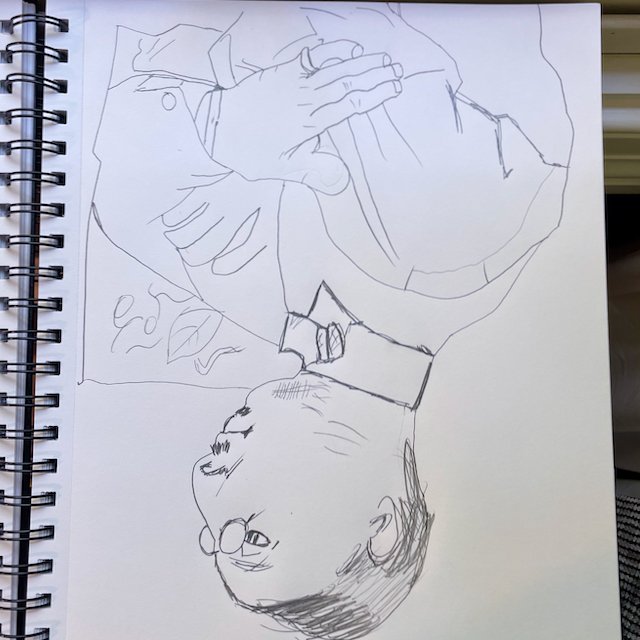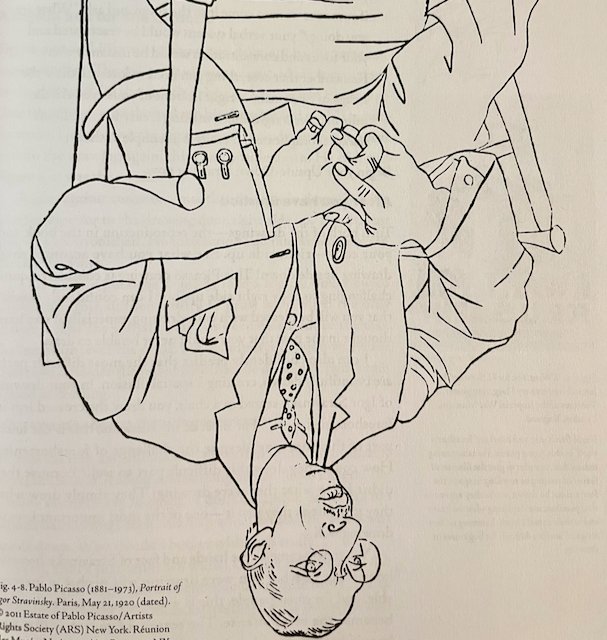Contour of the Keys
A contour drawing focuses on the edges of the object. Today’s exercise was to draw the contour of your keys without lifting your pen. The focus is on developing confident lines.
Doing it in pen, in this case, a Pilot Prera fountain pen) allows me to focus on the lines; there is no erasing or “starting over.”
After I set the contours, I went back and added the details. Excellent enjoyable exercise to start a Saturday morning.
Blind Contour by Feel
Today’s exercise was a blind contour by feel selfie. You place your finger on your nose, move around your face, and have your hand follow along. I like how my eyes are aligned and feel confident with my lines.
Another interesting exercise to develop confidence in my lines.
Blind Contour Drawing
Back to basics today.
I’m starting the Six-week Art Bootcamp class at Sketchbook Skool. This course is exciting. We start with pen and pencil on paper and work with colored pencils and watercolors.
Fun and exciting. I am looking forward to it. Today we completed a blind contour drawing. This technique is where you look at the subject only and let your hand follow your eyes.
I heard an excellent comment from author Neil Gaiman about writing in a new book, which is equally relevant to a new sketchbook. Remember, everything can be fixed except for a blank page. Draw on!
Water bottle
Here is a sketch of my personalized water bottle. It has been a while since I drew and posted something. I was thinking about where the friction has come from. As I have gone from pure novice to amateur, I have built unnecessary expectations. When you are a novice, you have no expectations and don’t self-judge what you are doing; you do it. When you arbitrarily cross over to amateur, you somehow develop expectations that lead to friction. Now I’m feeling somewhat disappointed in my drawings when I haven’t been practicing for very long.
Watch out for this arbitrary shift and the related increased expectations. The friction is not worth it.
Cup
I’m happy with the perspective on the cup’s top. I used the pencil measuring technique to measure the ellipse. The length vs. depth of the ellipse is much greater than your brain says it should be. That was key to getting the correct perspective. Today feels like a breakthrough day for me.
The overall balance of the cup’s sides is good. I am making progress one day at a time.
The Office Corner
Today’s sketch focuses again on the perspective skill. Using the picture plane, I drew my Basic Unit (the Formula One photography on the left of the corner) on my picture plane and then transferred that to my shaded paper.
From there, I drew the remaining elements. I’m happy with how I could draw the view to scale and didn’t run out of space on the page. Most everything in the view was captured to scale.
1% improvement!
The Corner
Today’s sketch focused on sighting the angles in a room corner with just a pencil. First, I drew the central vertical line, which always remains vertical regardless of the viewing angle. And then, using my pencil, I visually saw the angle for the floor and ceiling with the vertical corner.
Getting good and working these angles and tricking my left brain, which is convinced the lines are straight.
Focused on constant improvement day by day,
Vanishing Point down the Hallway
The vanishing point is a crucial tenant of drawing with the proper perspective. Understanding how the vanishing point works and how the straight lines converge down from above to the vanishing point and up to the vanishing point from below.
This plays havoc with your left brain because it knows these are straight lines. So forcing your left brain to give up and letting your right side brain take over and draw to the vanishing point is vital.
I have some work to do.
Apples on the Counter
Although a simple setup, today’s sketch offers the ability to so depth with a three-dimensional object and volume by showing the shadows with the paper towel under the apples and shadows from the apples.
I need to continue to work on all three, and utilizing a simple countertop setup like this will always give me the opportunity.
Three Potatoes
Today I wanted to try a live scene with directional lighting. So I set up three potatoes and my flashlight to provide specific directional lighting. I’ve included the original setup and my drawing. I am still working on getting the roundness of the potatoes, the surface texture, and the shadows, all with a fountain pen.
What do you think? Let me know in the comments below.
The Chair
Today’s sketch was a tough one. Trying to sketch the chair while getting the perspective and depth was hard. I tried to use the picture plane but couldn’t keep it still. I tried to focus on the negative space but couldn’t get that clear. Just an overall tough sketch today.
I’m not discouraged at all. This drawing shows where I need to put the work in. Nothing comes easy!
Picture Plane Practice - Hand
This is another hand sketch with the picture plane. Practice brings repetition, and I enjoy focusing on the lines, angles, and negative space, not that I am drawing a hand. It works as I focus on using my right brain and excusing my left dominant brain.
Enjoy
The Hand on the Picture Plane
Today’s assignment was to draw my hand in foreshortened view using a glass picture plane. This technique/learning tool was created back in the 1400s. This tool helps you see and draw a three-dimensional item on a two-dimensional plane.
It is unbelievably easy to trace my hand on the glass. It was interesting to me how the glass eliminated the stress and angst of trying to capture the depth of my hand. Instead, I focused on the lines and outside map of my hand and watch—a great learning experience.
I picked up a discount picture frame and a few cheap mats at the craft store—an inexpensive, practical glass picture plane.
Pure Contour Drawing - The Hand
Pure Contour Drawing – The Hand
An essential drill to help people develop their drawing skills was introduced in 1941 by Kimon Nicolaides; contour drawing. This drill helps build your skill in seeing the edges and contours of your subject.
In Drawing on the Right Side of the Brain, Betty Edwards modified the contour drawing into the pure contour drawing. Her drill has you looking at a subject, in this case, my left hand, and placing my other hand and pencil on the paper. I started the timer for five minutes and ONLY looked at my left hand. I followed the crevices and contours of my hand with my eyes and allowed my drawing hand to “follow” my eyes on the page.
Your outcome is a record of your perceptions of the creases in your palm, not a beautiful sketch of your hand.
Upside Down Man for the Third Time
Repetition. One more upside-down drawing to work on the right side of the brain. Progress.
Small wins include feeling more comfortable with the fingers. This is big as even upside down. My brain knows I am drawing fingers. It is much harder to trick my brain into focusing on lines and angles.
Another Upside-Down Man
Today’s sketch was another where you look at the image upside down. This exercise from the book Drawing on the Right Side of Brain reduces mental conflict. Drawing upside down uses the gap between recognition (knowing you are drawing a man) and drawing upside down, so you focus on lines, angles, and circles. In other words, use the right side of your brain.
This Drawing is from page 53 of Drawing on the Right Side of Brain and is by Pablo Picasso of the Russian Composer Igor Stravinsky.
It was enjoyable, and I focused on the lines and angles, not calling out a head, face, or hands. It works.
Inked Up
Today’s sketch is my recent fountain pen ink bottle and box. I wanted a subject to work on perspective and depth with both the square and round shapes. Still working on that bottle top shape – still too round.
The good news is that my images are not leaning as much as earlier as I focus on the landmarks and perspective. Making progress.
Circles
I’m just not happy with the proportions of the top circles on my cups and glasses. They are too round and not oblong enough to convey the depth of the cup. So I did a few pages of circles to practice and get the muscle memory down. The last few seemed to be much better, and my lines were strong and more confident.
Disney Mug
Hello, going strong with my sketch a day for 365 days. I’m really enjoying the process.

